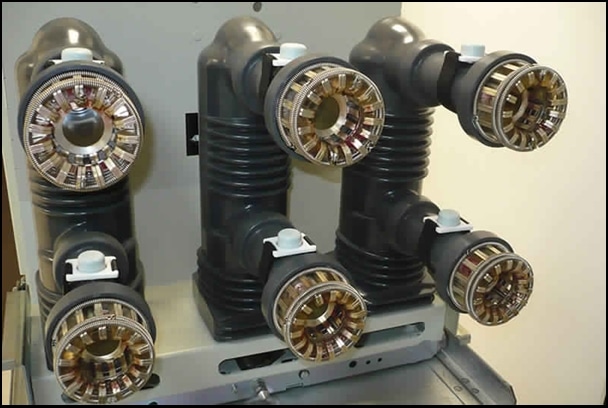Another article from AHand about the SSCBR function.
If you want to participate in the blog and see your work published in our blog followed by thousands members of the Electrical Engineering Community, feel free to send us a mail.
Circuit-breaker condition monitoring SSCBR
Usually circuit-breakers need to be carefully monitored, because they require maintenance after a certain number of operations.
However, there are many ways to monitor a single parameter, for example to know the number of operations of a circuit-breaker, one may just look at the mechanical circuit-breaker counter or read the same value on a computer far away. Functions like SSCBR make it possible to implement substation automation standards implemented by IEC 61850, which make the supervision and control of the plant components much easier.
The different parameters of the circuit-breaker can be monitored by the circuit-breaker condition monitoring function SSCBR, the output signals of this function can be simply displayed on a screen or sent to a remote-control room.
How does SSCBR work?
The function receives input signals from the circuit-breaker, which indicate its status. It constantly monitors the line currents, it also uses some of the signals to make calculations.
Basically, the function performs metering and monitoring sub-functions, it (1) checks the circuit-breaker status, (2) checks phase current, (3) indicates the contact position, (4) monitors the circuit-breaker operation, (5) monitors the inactivity time of the circuit-breaker, (6) measures the travel time of the breaker contact while opening and closing, (7) counts the number of operations of the circuit-breaker, (8) Calculates the accumulated energy Iyt, (10) estimates the circuit-breaker lifetime, (11) Measures the spring charge time and (12) supervises the gas pressure level inside gas interrupted circuit-breakers.
Sub-function: Contact position indicator
SSCBR can detect whether the circuit-breaker contacts are in the open or closed position by (1) checking the status of the binary input coming from the circuit-breaker internal circuit, which indicates that it is in the closed position, (2) checking the status of the binary input coming from the circuit-breaker internal circuit, which indicates that it is in the open position, (3) comparing the measured phase currents to a threshold set by the operator.
If the circuit-breaker signals indicate it is in the open position and not in the closed position and the measured currents are below the set threshold, then the contact position sub-function sends a signal that indicates the circuit-breaker is in the open position.
Another sub-function that performs the phase current check logic compares the measured three phase currents to the settings of the operator and then the contact position indicator changes accordingly.
Sub-function: Circuit-breaker status
To know whether the breaker is in an open, close or invalid position, the circuit-breaker status sub-function uses the input signals for current and circuit-breaker position.
Sub-function: Circuit-breaker contact travel time
The contact travel time is a very useful output of SSCBR, because it saves the time, effort and cost of making the contact travel time tests, which are usually done using circuit-breaker analysers.
The travelling time can be calculated for opening and closing operation using different methods. The calculator utilises the change in status of the circuit-breaker closed and open status signals and correction factors to determine the time.
Sub-function: Operation counter
The operation counter sub-function is quite useful for determining how many times the circuit-breaker operated, thereby useful to plan the maintenance schedule. The function calculates the opening and closing operations as one operation cycle. The operation counter value is updated for each operation. The sub-function senses the operation by monitoring the change in input signals.
Conclusions
Circuit-breaker condition monitoring function has been discussed, it is quite useful for extending the lifetime of the circuit-breaker, it is quite useful for remote supervision and control of the circuit-breaker and it depends on a set of sub-functions to monitor and make calculations about the circuit-breaker condition.
Some of the sub-functions of SSCBR were discussed in this article.
Further reading about circuit-breaker monitoring and maintenance in general
[1] Condition monitoring and maintenance strategies for high-voltage circuit-breakers http://ieeexplore.ieee.org/stamp/redirect.jsp?arnumber=/9353/29707/01351616.pdf
[2] Condition Monitoring System for Circuit Breaker Based on Substation Automation System http://ieeexplore.ieee.org/document/4218811/
Thank you all for reading,
AHand
Only some of the functions are listed in this essay, what more could you say about the topic? Comment or ask questions below!


Nice information about circuit breaker condition monitoring function.
My workplace is considering getting a circuit breaker monitoring system and service, and I wonder now if we’re going to get an SSCBR as you mentioned. It’ll be nice to be able to tell if what the status of our breaker is, whether open, closed, or invalid as you mentioned, without having to send someone down to examine it every time something happens with our electricity. I’ll have to talk to my boss about it and see if the system we’re getting can also do things like supervise the gas pressure level in gas circuit breakers, as you said.